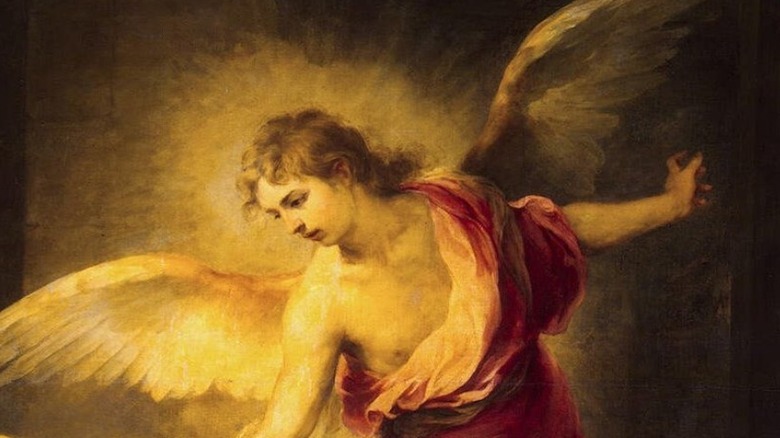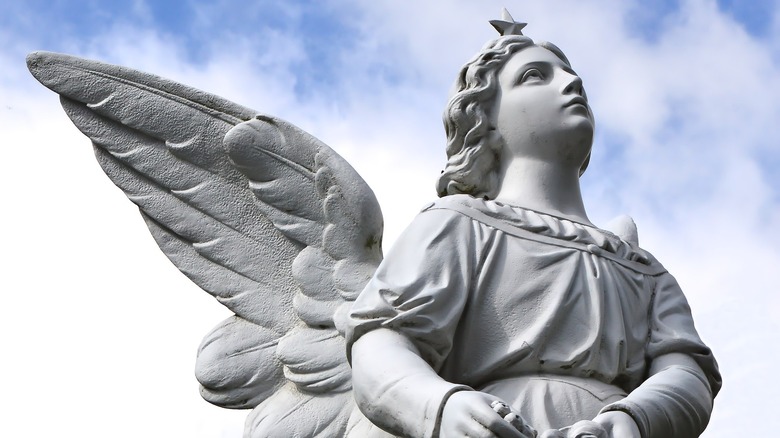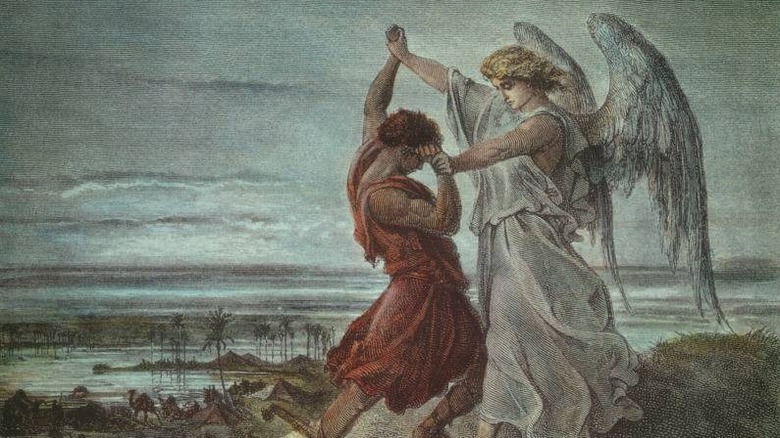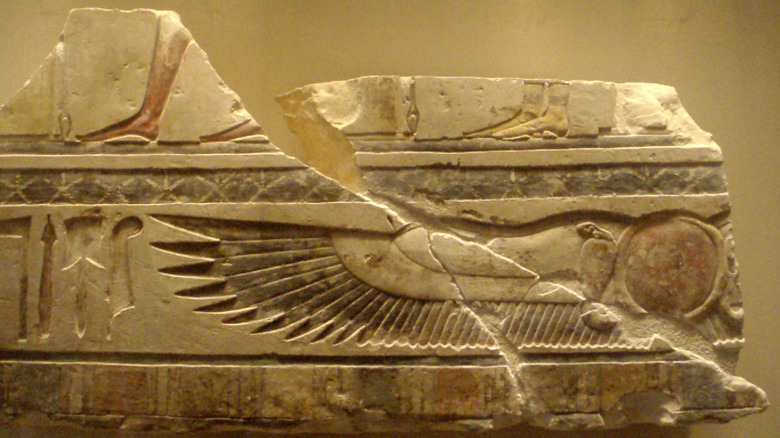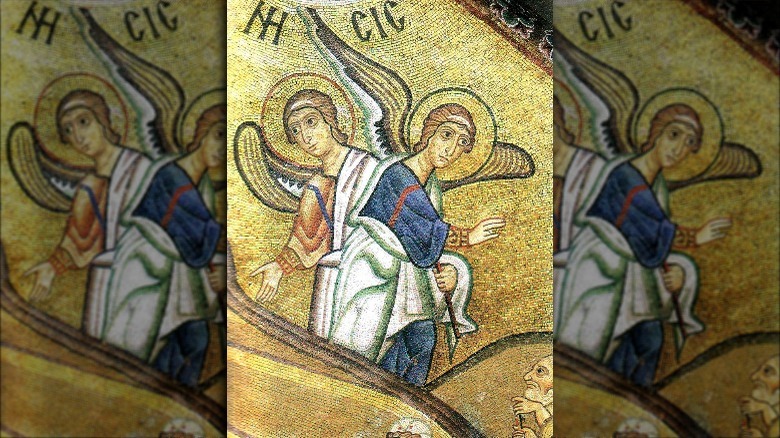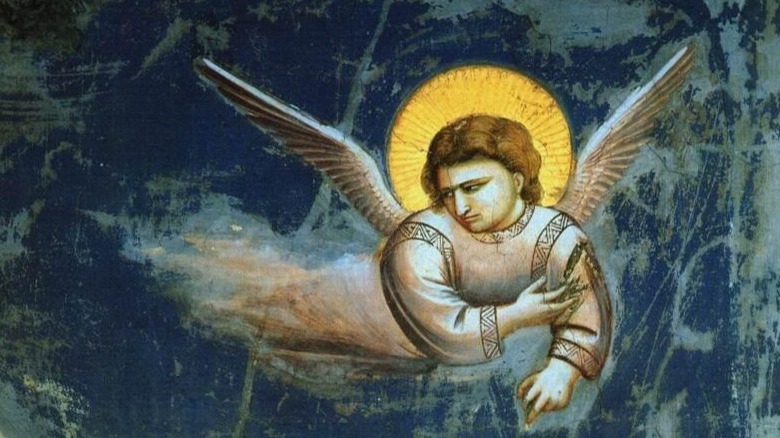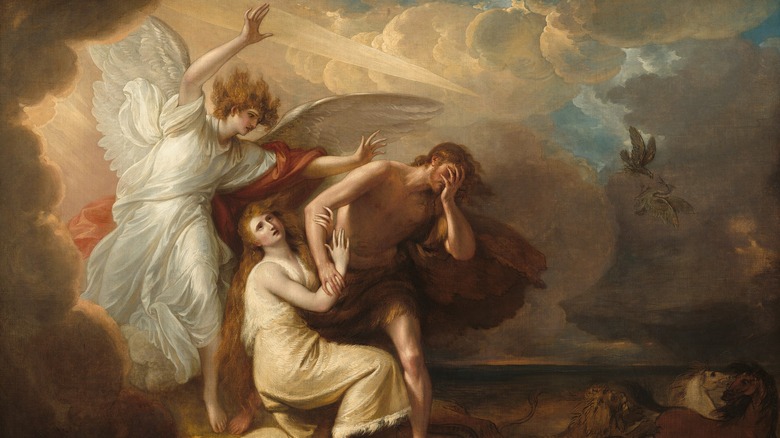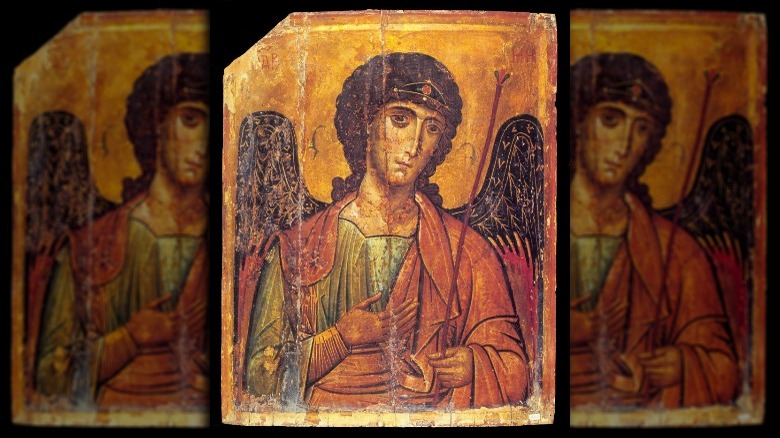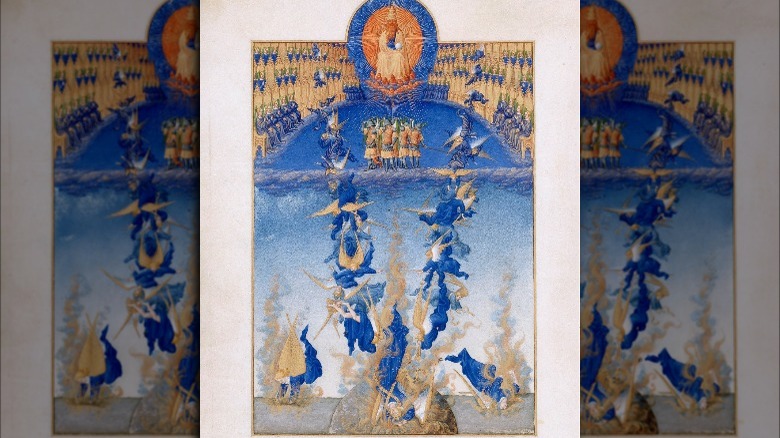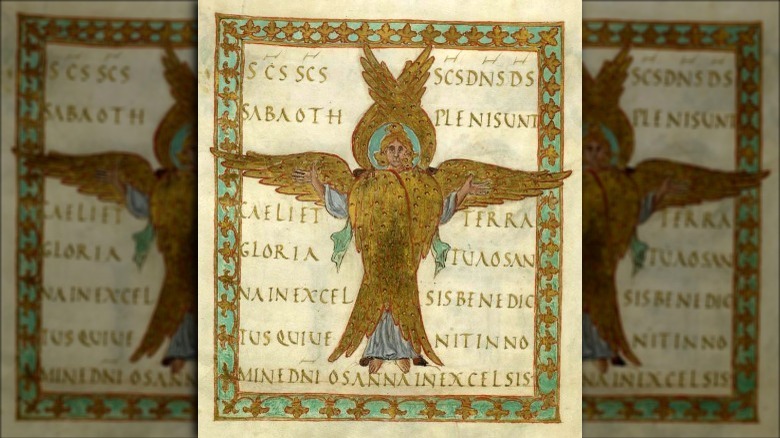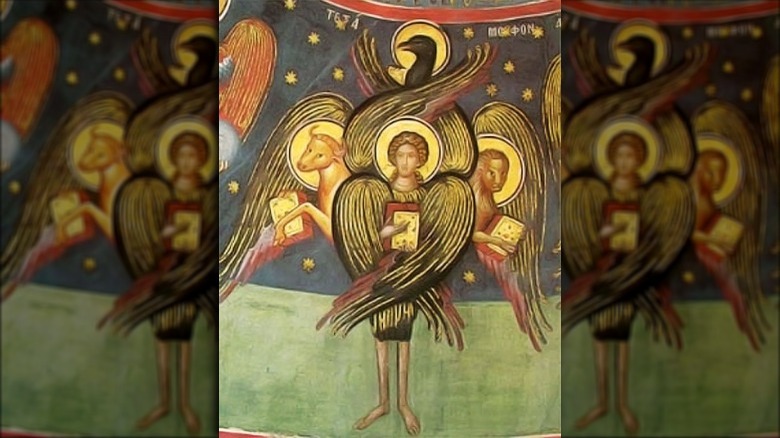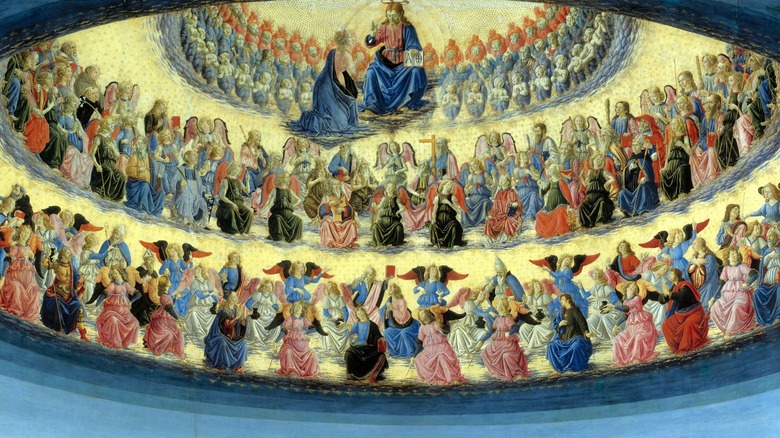Things About Angels In The Bible You May Not Know
So, you think you know angels. It's pretty easy, right? All you have to do is wander into a church and take a look at the stained glass panels, statues, or some other artwork to get at least a general sense of these heavenly beings. Or, you know, catch an episode or two of "Touched by an Angel," that '90s TV stalwart that showed more human-shaped angels doing good in the world. Either way, you may have already assumed that angels are beautiful spiritual beings with huge, feathered wings. They undertake various tasks for God, from announcing big events like the birth of Christ to protecting various everyday folks.
Only, the truth is that quite a lot of our modern conceptions of angels are the result of centuries of folklore and interpretation. And, moreover, all of that storytelling doesn't always perfectly line up with what the Bible has to say about angels. Maybe that's a bit of a shame, as an episode of "Touched by an Angel" where Della Reese appears as a true cherub, complete with four faces, two sets of wings, and a body full of blinking eyes, would at least have been interesting (though maybe not great for ratings).
Either way, diving into the truth of angels as told in Christian and Jewish scriptures that make up the modern day Bible could prove to be very surprising. These are a few of the things about angels in the Bible that you may not know.
In the Torah, angels aren't exactly angels
Broadly speaking, most people interpret the Torah as the first five books of the Hebrew Bible, also called the Pentateuch, per the British Library. These include Genesis, Exodus, Leviticus, Numbers, and Deuteronomy — all likely very familiar if you know the "Old Testament" of the Christian Bible.
But if you go digging for information about angels in the Torah or Old Testament, you may be surprised, depending on the translation you've got in your hands. Generally speaking, the Hebrew used in the Torah refers to "messengers of God" or even "sons of God" instead of angels, according to the Jewish Encyclopedia. Yet, the truth is that there's plenty of room for debate here, as the Catholic Encyclopedia notes that the phrase "son of God" could also refer to a very holy, but very human person, too. There's nothing in the original language that lets us know for sure that a real angel is involved. This means that an incautious translator might throw in an "angel" or two when the original phrasing calls for more careful consideration.
Yet, that's not to say there aren't any angels at all in the Torah, according to My Jewish Learning. There are certainly divine beings who intercede in human affairs on God's behalf, such as when an angel steps in to stop Abraham from slaughtering his own son, Isaac. It's just that the Hebrew words used for them don't translate perfectly into the English term of "angel."
Angels went from physical to spiritual beings in the scriptures
In early parts of the Bible, angels appear to be fully physical beings who can often pass for human and certainly are able to interact with the earthly realm in very concrete ways. Take the story of Jacob and the angel, wherein the Biblical patriarch wrestles all night with an angelic being who refuses to give the human its name (via My Jewish Learning). The Book of Genesis makes it pretty clear that this semi-divine creature is sent from God and, given that the being in question apparently dislocated Jacob's hip, they clearly have an effect on the physical world and the humans within it. And if you're fretting over Jacob's injury, don't worry. He walks it off and gets both a new name ("Israel") and a divine blessing out of the struggle. There's also the story of Lot in Genesis 19. He unwittingly hosts two angels in the city of Sodom. The angels mean to save the righteous Lot and his family from the city's coming destruction, but initially neither Lot nor the crowd that gathers outside of his home realize that the strangers are anything other than human.
But, by the Hellenistic period centuries after the first books of the Bible were written, angels seem to have lost their physical bodies and become fully spiritual beings. According to Britannica, both Biblical prophets Ezekiel and Isaiah speak about angels in fully spiritual forms, describing them as without physical bodies.
The Bible's ideas of angels may have come from ancient Egypt
For some scholars, it's possible to see throughlines from the early days of the Hebrew scriptures to the modern Christian idea of angels. Some believe that it's possible to go back even further and see the earlier inspiration for these semi-divine beings in a culture that would have been familiar though still very foreign to the ancient Jewish people moving throughout the region.
According to a PhD dissertation via Stellenbosch University, it's quite possible that ancient Hebrews may have taken some angelic cues from the ancient Egyptians. Namely, Egyptian people thousands of years ago had already established a sort of divine hierarchy, with a primary god who used intermediaries to go between the world of the gods and the mundane realm of humans. Common motifs like those of heavenly thrones and divine fire link the two belief systems, which may have crossed paths most readily during the exile of Jewish people into Mesopotamia around 600 BCE.
Furthermore, Britannica notes that ancient Egyptians frequently used wings to mark out divine or semi-divine figures in their belief system, like a winged sun disk meant to represent Horus. To be fair, there's no smoking gun here, like a clay tablet, stone inscription, or scroll wherein someone in the Jewish community admits that they took a liking to foreign religious influences. Yet, the parallels are intriguing and, for many scholars interested in Biblical angels, pretty hard to ignore.
The Nephilim of Genesis are connected to angels, but it's complicated
Quite a few sources may confidently tell you that the Nephilim mentioned in the Book of Genesis have their origins in angels that came down to Earth. According to the Biblical Archaeology Society, the common narrative is that the "sons of God" — commonly interpreted to be the divine beings we now call angels. The sons of God descended from the heavens, paired up with the human "daughters of Adam," and created the half-human group that would be known as the Nephilim, which literally translates to "fallen ones." That's not a reference to their moral status, but more accurately a reflection of how something divine has "fallen" a realm or two downward into the human sphere.
In some variations of the story, these half-angel offspring were apparently so offensive that God caused the great flood to get rid of them. Sometimes, the Nephilim are also equated with the "giants in the earth" so often referenced in Biblical traditions, but there isn't a whole lot within the scriptures themselves to support this particular detail.
Yet, as the Biblical Archaeology Society argues, both of the above are pretty simplistic takes on a text that's already pretty tough to translate both linguistically and culturally. And consider also that Genesis 6:4 seems pretty laudatory towards the Nephilim, calling them some variation of "mighty men" and "men of renown."
Angels and demons aren't strictly linked in the Bible
For many people, the host of angels and demons are like two inextricably linked sides of one great battle. And the two are so deeply connected because, in the case of the demons, they were once angels as well. Or were they?
The truth, at least as it's reflected in the Bible, is quite a bit more tangled than folklore might have you believe. According to the Journal of Biblical Literature, there's very little at all in the Hebrew Bible to support the notion of fallen angels turning into demons. In fact, ancient Jewish people don't seem to have thought they were connected at all, especially once you start digging into the details of translating texts from archaic or Biblical Hebrew into later languages such as Greek and English.
The conflation of angels and demons appears to have been the invention of Christian writers, only first showing up in the New Testament in some pretty vague language. The concept of rebellious angels being kicked out of Heaven and becoming fundamentally evil only really gained popularity sometime around the 3rd century CE. The confusion may have arisen in part because of a misunderstanding of the Greek word daimon, which could have been meant to refer to all manner of things. These could include inhuman spirits, gods, human souls or even the entire concept of the divine — and without a moral judgment as to the nature of these different beings.
The Bible acknowledges that some angels may be morally ambiguous
Far from being squeaky clean beacons of goodness, angels can get real scary. Consider Genesis 3:24, which describes the aftermath of Adam and Eve's rebellion and just how God wanted to make sure the two wouldn't get back into the Garden of Eden. Cherubim are placed at the east perimeter of the garden and given flaming swords to ward off intruders. The angels here are certainly working for the Almighty, but neither would you want to cross them.
And while some angels are terrifying but ultimately considered to be on the side of good, others fall into a moral gray area. Remember that an "Angel of Death" swooped over Egypt to kill the firstborn children of the land in Exodus and who already had extensive experience in that arena by that time (via Jewish Encyclopedia).
The Journal of Biblical Literature further notes that, in some scriptures, evil spirits were also referred to as "angels," like an "Angel of Darkness" that intentionally pushes people away from righteous living. There are also Old Testament references to a "satan" that acts as a kind of prosecuting attorney for the divine, while still very much in the employ of God. Later interpretations of the Bible that focus on "fallen angels" also inherently acknowledge that angels have both the ability to think independently and to choose the side of evil that opposes God and oftentimes seeks to lead humanity astray.
Archangels are only directly mentioned twice in the Bible
Folklore traditions generally hold that there are seven archangels. According to The Guardian, they include Michael, Gabriel, Raphael, Uriel, Raguel, Sariel, and Remiel. While that may make for some interesting stories and an overall concept of a heavenly hierarchy where this team of big-time angels act as upper management, it's not strictly Biblical. Those last four angels are only named in the Book of Enoch. And, if you happen to have a copy of the Bible handy, you can easily confirm that Enoch isn't a standard book of the Bible. It's actually an apocryphal, non-canonical book that mostly focuses on the apocalypse (via Britannica). Some archangels also appear in other apocryphal works, but things like Raphael's appearance in the Book of Tobit aren't necessarily going to make an appearance in the next Sunday sermon.
So, which of the archangels are actually mentioned in the Bible? Only two, as it turns out. Per The Guardian, the archangel Michael pops up in the books of Daniel, Jude, and Revelation. Daniel 12:1 specifically references Michael as a "great prince" who watches over the Jewish people and will protect many during the apocalypse.
Meanwhile, the archangel known as Gabriel also appears in the Book of Daniel. He shows up again in the New Testament Book of Luke, where he's tasked with announcing the coming of John the Baptist to the prophet Zechariah and then the birth of Jesus to the Virgin Mary (via Britannica).
Biblical evidence for fallen angels is surprisingly vague
It may seem painfully obvious that Lucifer — also known variously as Satan or just the plain, old Devil — is a formerly good angel gone bad. It's right there in a myriad of books, comics, and films, like 17th century writer John Milton's epic poem, "Paradise Lost," which hinges on a darkly dramatic and rebellious Lucifer railing against God and Heaven (via National Geographic). Even a half-hearted viewing of Hollywood films like "The Prophecy" and "Constantine" make it pretty plain. But, if you were to discard all the modern-day storytelling and dig into the Bible itself, you would find that the textual evidence linking fallen angels to the forces of evil are actually very shaky indeed. It's far more tenuous of a connection than many modern sermons and pop culture takes would have you believe.
According to History, the confusion comes from Isaiah 14:12-14, which references a "Lucifer" (often translated as "morning star") who's fallen from Heaven. And Luke 10:18 does refer to Satan tumbling "like lightning from heaven." Yet, it's not at all clear that Lucifer and Satan are the same personage. That all appears to have been a later invention of people who read and translated the Bible, but definitely didn't write the original works. And while sources like Open Bible offer up plenty of verses that ostensibly reference fallen angels, very few indeed make the sort of clear connections necessary to satisfy Biblical scholars on this front.
Seraphim look nothing like pop culture angels
Maybe you've seen angels in sugary sweet, mass-produced oil paintings or perhaps a curio on a grandparent's knick-knack shelf. That particular angel probably looks like a beautiful human dressed in flowing robes and with great, feathery wings sprouting from their back. But, if you were to encounter a Bible-accurate angel like those described by the prophet Isaiah, you would surely be shocked by the strange creature in front of you.
The creature in question might well have been a seraph (or seraphim when they appear in a group). According to Britannica, these angels — also known as the "burning ones" — first appear in the Bible in the Old Testament vision of Isaiah. They have six wings, with one pair to hide their faces and another set reserved to conceal their feet (via Jewish Encyclopedia). The remaining set of wings is what allows these angels to fly about.
Isaiah sees them standing before the throne of God, praising the Almighty while one makes its way to Isaiah to cleanse the human man with a coal taken from the temple altar. Otherwise, there's not much in the way of a clear description, though scholars think that the seraphim may have their roots in a half-lion, half-eagle Egyptian creature known as a seref. Other pre-Biblical scriptures linked to these angels also seem to reference serpents and dragons. Yet, we can still be sure that it's all a far cry from a twee porcelain figurine.
Biblical cherubs aren't cuddly angel babies
Amongst the preconceptions you may have about angels, there's surely a serene, chubby baby with little wings: the cherub. Nowadays, cherubs are pretty popular little creatures, showing up in all sorts of artistic and pop culture contexts. But, as you may have already guessed, the Bible isn't about to present you with an adorable, angelic toddler when it starts to discuss cherubs. Rest assured that it's got something far stranger up its sleeve.
According to My Jewish Learning, cherubim are first mentioned in the Book of Genesis, where they're given flaming swords and tasked with keeping those sinful humans out of the Garden of Eden and away from the immortality-granting Tree of Life. Their images also appear in golden form on top of the ark of the covenant, the decorative container that holds the Ten Commandments. It all ties in with their oft-mentioned role as fierce guardians — you really, really don't want to mess with a cherub.
Not that you would actually consider such a thing if you were to see the cherubim as they're described by the prophet Ezekiel. In Ezekiel 10, he claims that cherubs actually have four faces, with one each of a human, lion, eagle, and a more mysterious "cherub" face. They also have two sets of wings, seemingly human hands, and bodies covered entirely in eyes. In Ezekiel's vision, each cherub is also accompanied by a wheel that "sparkled like topaz" and followed each angel's movement.
The hierarchy of angels is mostly a post-Bible invention
While the Bible contains some information about high-ranking angels (implying but never really describing an overall hierarchy), more complete information comes from people writing only after the canonical Bible was more or less established. Early Christian author and philosopher Pseudo-Dionysius the Areopagite, who worked in the 5th and 6th centuries CE, was one of the earliest Christians to outline the hierarchy of angels, at least as he saw fit. According to the Stanford Encyclopedia of Philosophy, Dionysius was pretty focused on establishing hierarchies within his religion, perhaps in an attempt to strengthen the structure of the church and Christianity in general.
In his writings, the hierarchy of heavenly beings includes nine ranks of angels, which rank the six-winged seraphim towards the bottom, followed up by four-faced cherubim, then a progressively exclusive set of higher beings that include "dominions," "principalities," and archangels (via The Arcanum). Meanwhile, the Mishneh Torah, a code of law written by medieval Jewish scholar Maimonides, also discusses various ranks of angels and spirits. Yet, you won't find much, if any textual evidence for this very complex sort of arrangement of the angels in the Bible itself.
